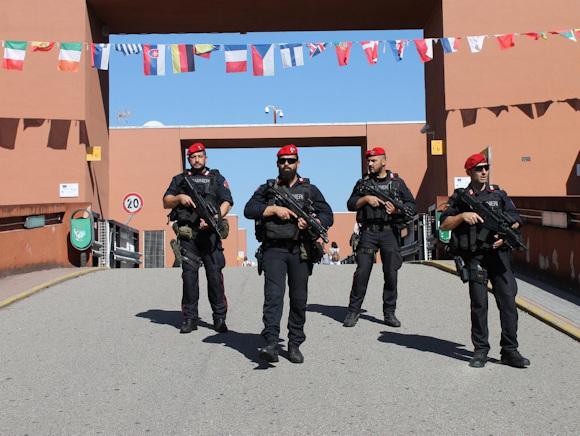The Art.83 of the TFEU (ie the Treaty on European Union and the Treaty on the Functioning of the EU), ex Art. 31 of the TEU (Treaty on European Union), makes explicit reference to terrorism as a "serious crime".
Art.88 of the TFEU, assigns to Europol, the task of supporting and strengthening the action of police authorities and other law enforcement agencies and mutual cooperation in the prevention and fight against terrorism .
Europol (European Police Office or European Police Office), operational since 1 July 1999, is the agency for the fight against crime in the European Union. Among its many missions, a priority in recent years has been the prevention and fight against terrorism which, in recent years, represents a considerable threat both to the internal security of the EU and to the security and existence of its citizens.
With the "Modus Operandi Monitor", Europol offers a broad model of activities capable of continuously assessing terrorist events and investigations in the spheres of terrorism, focusing on specific elements of the terrorist "modus operandi". A quid pluris it is given by the "first aid network", which offers assistance to any Member State grappling with a serious terrorist event, bringing national experts from this state into contact with an international platform of counter-terrorism experts and intelligence analysts from Europol.
In this way, it is possible to access an international database of people suspected of terrorism and extremists. With the "first-aid network", strategic advice from high-level experts is also offered, in the event of an attack.
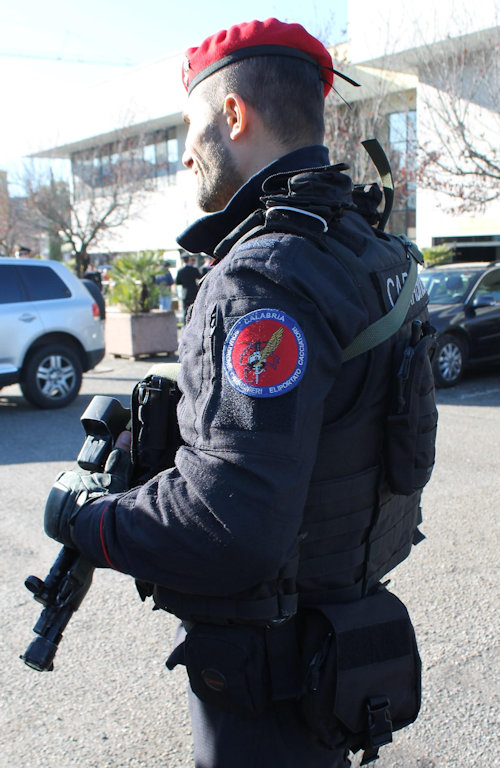
Regarding the possible future ISIS threats, Europol's latest report on terrorism shows the high risk of jihadist attacks with explosive drones, chemical, biological, radiological and nuclear weapons. The EU law enforcement agency warns of the risk that the technique already used by the Caliphate, used in the "crises in Iraq and Syria", could inspire others, including in Europe. Both Iraq and Syria continue to be the "gym" for ISIS and Al-Qaeda groups. Europol believes that both have "volunteers, intention and ability to implement complex mass attacks in the West". Even if ISIS moves back online on the production and dissemination of its propaganda, for the measures taken by social network platforms, it still manages to solicit actions, sharing tactics and objectives.
In the same report, we highlight the more operational role that women assume in jihadist terrorist activities in Europe, as well as children or young adults.
Relevant is the annual report that Europol provides on the terrorist matrices of the attacks divided into different categories: most of the terrorist attacks in the EU are linked to ethno-national or separatist reasons. In smaller numbers follow the attacks associated with right-wing groups or "religiously" motivated terrorist attacks. Among those arrested for terrorist crimes, most are included in the religious classification and then followed by separatists.
The main causes of terrorism refer to the geopolitical context rather than to the religious context. The phenomenon of terrorism is often brought back to the religion professed or presented as a justification for the actions of terrorists. Being terrorists today does not mean being Islamic or practicing the Islamic religion. We must not get lost in these commonplaces. Becoming a jihadist terrorist is often independent of being a practicing or a strict Muslim. Many terrorists are converted Europeans, former criminals and stragglers, socially marginalized or petty-bourgeois.
The contemporary terrorists are radicalized in "do it yourself" and operate in a "swarming" way, that is like swarms and not for armies or cells. The swarming they are "network-centered" structures, ie self-sufficient cells inserted in one of the terrorist networks (networks) that share knowledge, information, tactics and logistics on a horizontal level and with vertical references at an ideological, image, financial and training level. Terrorist networks are familiar, friendly or built on the ground in fighting in Syria or other theaters of the terrorist front. They are rarely rigidly hierarchical structures. This type of aggregation guarantees flexibility, elasticity and secrecy with an offensive capacity superior to that of terrorists called "solitary wolves".
Radicalization also takes place in prison through the network or frequentation of radical associations and almost never in mosques. The process of radicalization being individual and unstructured is very difficult to monitor. The technological and communication tools guarantee to keep the network secure and through the free media propaganda they terrorize public opinion. The upper hierarchical levels in the Middle East guarantee military training and finance these terrorists. The knowledge of Islam and traditions by terrorists is often superficial, outward and sketchy. It is conceptually, as well as morally, wrong and misleading to still consider the "bombers" as the representatives of all Muslims in the world.
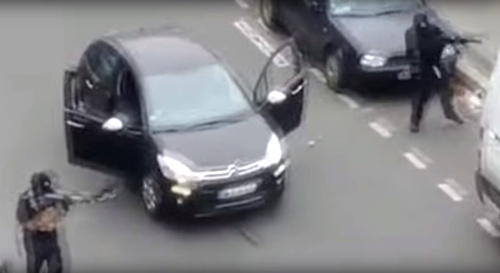
Terrorism must be secured at an operational and tactical level, as the contemporary terrorist is a military target. Certainly not a "classic" military target that can be struck as a military target would be faced or with counterproductive and ineffective actions.
The European continent is under attack by Islamic terrorists from the 2015: the Kouachi brothers first with the attack on the writing of Charlie Hebdo, and the commando led by Abdelhamid Abaaoud later with the tragedy at the Bataclan, have changed the way of "operating" terrorists . The scenarios of these attacks were among the worst that could happen to the French Special Forces: in reduced numbers due to the high training standard required that does not allow large numbers of operators. Waiting for their intervention allowed terrorists to act and make many victims for many minutes.
Following the attacks in Paris, the security forces of many European states have pointed out that the attackers act quickly with small groups of fire, simultaneously in several crowded places, to create chaos, shift attention and to make the highest number of victims.
From the need to respond to the attacks of this new typology, the capacity of intervention of some elite departments was prepared and refined, above all to try to stem terrorists in the first actions awaiting the Special Forces. More simply to create Units trained to conduct direct actions.
The Arma dei Carabinieri, already from the 2015, if it materializes also in Italy, a terrorist attack centered on the simultaneous use of multiple fire cores, has on the national territory an imposing antiterrorism contrast system for numerical consistency, versatility and specialization, strengthening the capabilities of the Territorial Weapon and the Mobile Units. Specifically, on the national territory, the deployment of the anti-terrorist specialists of the GIS is planned with the support of both the 1 Regiment Carabinieri "Tuscania" paratroopers and the Units named respectively: the APIs (First Intervention Aliquots) and the SOS (Operational Support) respectively relating to the territorial organization of the Arma and the Mobile Departments.
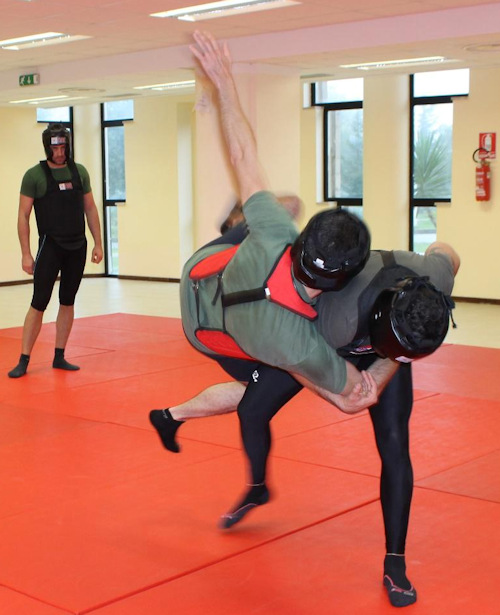
Both for APIs and SOS there is a precise structural and operational organization. The revision of the training and the equipment of the emergency personnel of the Territorial Ward (Nuclei or Aliquote Operative Radiomobili) was fundamental in order to face quickly and resolutely a sudden and complex terrorist threat before the intervention of the GIS.
The Arma dei Carabinieri has 18 First Intervention Rates, of which 16 operates in as many national provincial capitals and 2 aliquots drawn from the special departments of the Carabinieri Cacciatori of Calabria and Sardinia.
An operational distinction needs to be made between the First Intervention Fees active in the provincial capitals and the first intervention rates of the Carabinieri Cacciatori di Calabria, in this specific case. The ratio in both uses of these units is to have the rates immediately available to intervene on the places in which they operate. Also the type of armament used changes, because the type of employment is different. Priority task of the API units is to diversify the objective: to focus on the "threat" to direct the attention from civilians to the military who must provide to freeze it, neutralize it and if necessary confine it to bring it down.
The API units that operate in the provincial capitals, are identified by the General Command of the Carabinieri on the basis of the criteria of greater sensitivity to the terrorist danger. They are linked to their specific Territorial Command to which they belong to strengthen the anti-terrorism capacities of the Territorial Departments of the Carabinieri. They are not "traditional" Radiomobile patrols, they do not stay in the barracks waiting for a call to intervene. They are patrols with targeted training and specific endowments for the first fight against terrorists. They are a robust implementation of the "normal" daily patrols engaged daily on the territory. They perform specific shifts of prompt employment, 24h on 24h to protect the sensitive objectives of the provincial territory of belonging. In the event of an emergency, they are ready to intervene because they are constantly present on the territory. These military, monitor sensitive targets, dynamically control highly frequented places such as railway stations, places of worship, bus stops, public buildings, shopping centers, courts and airports.
The API units constituted by the Carabinieri Cacciatori di Calabria "watch" a specific objective both on the whole Calabrian territory (except Reggio Calabria which has its own API units) and outside the region, or on the whole national territory at the disposal of the General Command of the Weapon. Their use is foreseen at the occurrence of an event defined in places with presence of sensitive objectives such as universities, conferences, national events etc. The presence of an immediately available tax rate allows intervention on the spot. It is important to underline that the first intervention rate of the Carabinieri Cacciatori di Calabria (like the other API units) is not used for preventive but repressive purposes. What matters is the choice of the observation point in the place where these specialized units are located, to keep under control the whole area to be monitored.
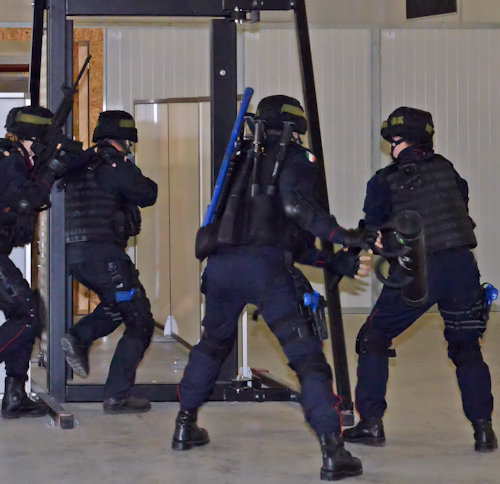
The request to use the API units of the Carabinieri Cacciatori di Calabria requires a specific request as per the standard circular approved by the General Command, which regulates not only the establishment but also the use, equipment, armaments and methods of use of the 'rates.
All the work concerning the antiterrorist prevention lies with the Departments of the Territorial Weapon.
The personnel in the API units of the Carabinieri Cacciatori di Calabria Eliportato Squadron is voluntary (the operative staff of the APIs active in the provincial capitals, comes from the radio-mobile units). They undergo a preventive psychological screening and a psycho-aptitude test to assess the level of psychological motivation, because the risks and stress they face are or may be very high. The first 3 weeks training course was held at the CoESPU (Center of Excellence of the Carabinieri for the Training of International Police Departments for Stabilization) in Vicenza. The GIS instructors have been entrusted with the training that includes notions of hand-to-hand combat, first aid operational, combat in urban environments, static and dynamic shooting training, simulations of operations counter IED e active shooter. A course for API units is divided into practical modules (including the CQB-Close Quarter Battle Training, or intervention techniques in public places considering the entry routes and emergency exits / security) and in theoretical modules (for the planning of the intervention, retrieve information on the plan, on the structures, etc.).
For about two years the formation of the API (and SOS) units has been entrusted to the staff of the Interforces Center for Military Applications (CISAM) of Pisa. The API operators are able for the following training procedure to interact operationally and tactically with the Arma incursors. At the end of the course the staff is ready to use. It must necessarily maintain the qualification with monthly training to be carried out in its department and observe an annual call to the CoESPU. The active API units usually consist of 4 men, equipped with a specific combat suit, a bulletproof vest with ballistic plates, ballistic helmet, bulletproof shield, personal radio and a "combatcam" (it's a bodycam with which you can record audio -video to infrared (IF) to "guarantee and protect" the performance of the service.With armament also features non-lethal devices, such as tonfa sticks and stinging spray, in addition to traditional short weapons and several new types of long weapons. vehicles supplied are the Subaru Outback and Forester SUVs, fully armored and equipped with the command and control system "Odino 3" (Operational Device for Information Networking and Observation) available on tablets to be always in connection with the operational centers of the Carabinieri.
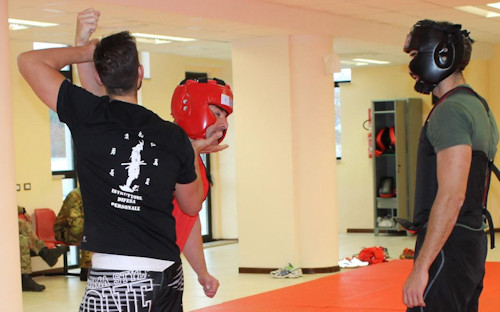
In addition to being appropriately equipped with armored cars and special weapons, they are also appropriately trained: the personnel receive an adequate training to be able to analyze the anthropometric characteristics of the aggressor, the actual intention of the same and the surrounding environment. During the training, the study plan includes lessons in applied psychology by specialized military personnel. We also provide a series of basic anatomy and physiology knowledge useful for an appropriate application of the techniques: in order to avoid injury during the operative intervention, while allowing an effective blocking and immobilization of the aggressor.
The training of the API units of both the Carabinieri Cacciatori of Calabria and those operating in the provincial capitals, is entrusted to personal defense and technical disarmament instructors.
No operator must ever engage in a close combat that endangers his life or that of the "protected", if this happens the reaction must be quick and instantaneous without leaving a response to the attacker. We must know how to manage a potential threat or aggression, trying to "freeze" it.
They are the 8.30 and like every Saturday morning, the staff API, is ready to train on the gym tatami: with bare hands and against simulated attackers with different physical characteristics: the instructor tries to reproduce different variants between the attackers to make the situations as as realistic as possible.
In the first training phase, the instructor indoctrinates the staff on flips and falls (back, side, forward). And again on parades (high, medium and low), dodge movements, rotation and torsion with the aim of reducing the distance during the defense action by making a shift of the lower limbs with rotary movement and a synergistic torsion of the torso.
In the second phase, on the other hand, the program includes training on judo and karate techniques: joint and shoulder joint levers, hand use as a weapon and joint levers on wrists, knees and ankles. The development of control, immobilization and handcuffing techniques is fundamental.
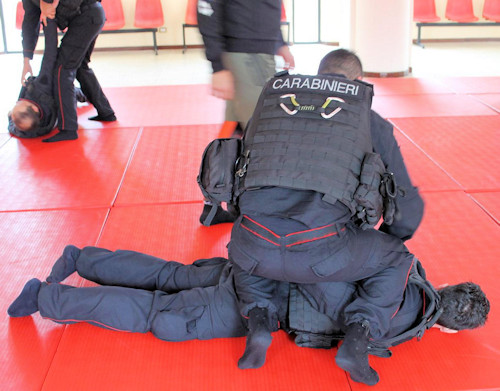
Following the learning phases for the personal defense and disarming techniques, "possible" scenarios that could occur, to evaluate the preparation, the reaction speed and the intervention of the API operators are simulated. Among the simulated attacks: a frontal blow from the high, a frontal grip on the chest with one hand and with two hands, a frontal neck grip, a front kick, a circular kick with a blow to the hip, a frontal attack with a gun and a frontal stab (obviously gun and dagger of plastic).
It is necessary to avoid the attack of the blow possibly with a lightning move and try to land the aggressor with a lot of blocking, disarming and handcuffing. We must be able to anticipate, stop and control by making sure.
All API units, despite the complex technique designed to evade, disarm and block the attacker, are capable of handling attacks, taking into account the various theoretical and practical aspects of self-defense.
The API units of both the Provincial Commands and especially those of the Carabinieri Cacciatori of Calabria (such as those of Sardinia) are an essential tool set up by the Carabinieri, to strengthen the anti-terrorism devices on the national territory. These units are capable of dealing with the terrorist threat in all its possible facets: they allow an emergency response and improve counter-terrorism defenses in places potentially at risk of terrorist attacks.
They can coordinate with the other police forces and in particular with the First Intervention Operative Units (UOPI), a department of the State Police present at the General Prevention Offices and Public Rescue of the Police Headquarters of some major Italian cities. They have the task of preventing, repressing acts of terrorism and intervening in high-risk situations.
It is obvious that the war on terrorism is not won by bombarding some training camps and repeating that Islam is a bad religion. Terrorism must be recognized as a "problem" of a military nature and entrusted to military and intelligence apparatus, also strengthening coordination with European agencies. It is not a phenomenon of operational competence of the "normal" jurisdictional system, which must deal with the collection of information based on human factors and operators, on the infiltration and interrogation of terrorists, on collaboration with the countries of origin and with other intelligence, without forgetting the necessary support of technology.
Terrorism may seem religious in its pretexts but is geopolitical in its origins and purposes.
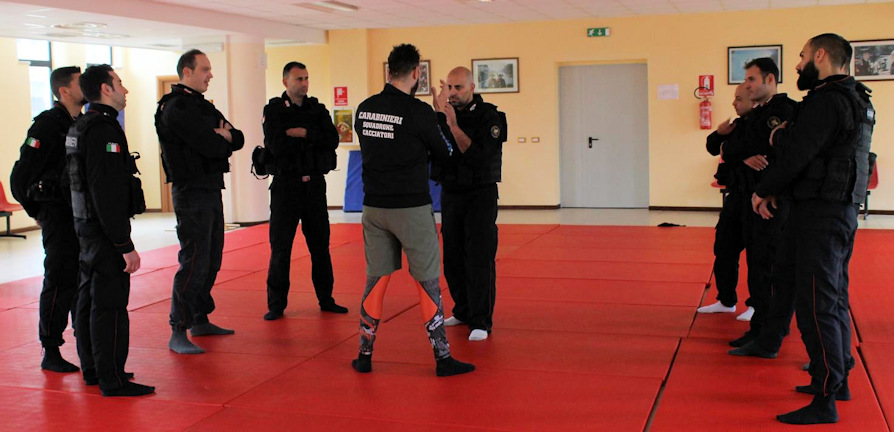
Read also: Harassed Squad Carabinieri Calabrian hunters (first part): beyond courage
(photo: author / web / US Army)

